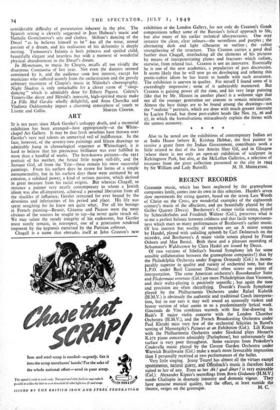ART
IT is ten years since Mark Gertler's unhappy death, and a memorial exhibition has been arranged—how appropriately—at the White- chapel Art Gallery. It may be that fresh novelties have thrown over Gertler's very real talents an unmerited veil of indifference. In the face, however, of the seventy-two paintings and fifteen drawings so admirably hung in chronological sequence at Whitechapel, it is hard to believe that his precocious brilliance was ever fulfilled in more than a handful of works. The best-known pictures—the 1911 portrait of his mother, the lyrical little teapot still-life, and the - Servant Girl, all from the Tate—these remain his most successful paintings. From his earliest days he strove for forms of a simple monumentality, but in his earliest days these were animated by an emotion, a subdued power, a kind of serious passion, which derived in great measure from his racial origins. But whereas Chagall, to instance a painter very nearly contemporary to whom a Jewish idiom was also all-important, achieved a personal liberation from all the shackles of influence, Gertler remained for ever bound by the devotions and inferiorities of his period and place. His life was spent seazching for he knew not quite what. For all his borings in French painting—Renoir, Cizanne and Picasso were the most obvious of the sources he sought to tap—he never quite struck oil. We may salute the steady integrity of his endeavour, but Gertler must surely remain, in retrospect, one of a generation rendered impotent by the hypnosis exercised by the Parisian colossus.
Chagall is a name that obtrudes itself at John Craxton's new exhibition at the London Gallery, for not only do Craxton's Greek compositions reflect some of the Russian's lyrical approach to life, but also many of his earlier technical idiosyncrasies. One may instance the clean, clear colours—the vermilions and purples ; the alternating dark and light silhouette or outline ; the cubist strengthening of the structure. This Craxton carries a good deal further than Chagall, interlocking all the elements of his pictures by means of interpenetrating planes and fractures which radiate, starwise, from related foci. Craxton is not an innovator. Essentially he is one of the new academics, a populariser of past discoveries. It seems likely that he will now go on developing and refining this poetic-cubist idiom he has learnt to handle with such assurance. The exhibition is uneven in quality. For myself I found some of it exceedingly impressive ; some of it unbearably mannered. But Craxton is gaining power all the time, and his very large painting (like that by Mr. Minton in another place) is a welcome sign that not all the younger generation are content to remain miniaturists. Almost the best things are to be found among the drawings—not the " realistic " portraits, which are done with much greater intensity by Lucien Freud, but those post-cubist heads like Nos. 25, 26 and 27, in which the formalisations miraculously explain the forms with the utmost economy.
Also to be noted are the exhibitions of contemporary Indian art at India House (where K. Krishna Hebbar, the first painter to receive a grant from the Indian Government, contributes work a little related to that of the late Amrita Sher Gil, and in Glasgow (where there is not only an open-air exhibition of sculpture in Kelvingrove Park, but also, at the McLellan Galleries, a selection of treasures from the great collection presented to the city in 1944 by Sir William and Lady Burrell). M. H. MIDDLETON.






































 Previous page
Previous page